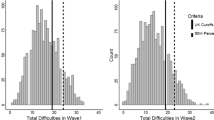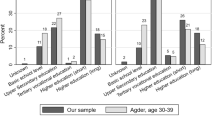Abstract
Purpose
This study compared the behavioral problems of children living in an SOS Village, which attempts to provide a family setup for its children, with those living in conventional orphanages.
Methods
We conducted a cross-sectional survey of 330 children, aged 4–16 years, living either in an SOS or other conventional orphanages of Karachi, and assessed their behavioral problems using strengths and difficulty questionnaire (SDQ). Behavioral problems on composite SDQ and subscales, rated by foster mothers, were compared between children in the two groups using χ2 test of independence. Multivariable models were built, using generalized estimating equations (GEE) regression approach, to identify factors independently associated with behavioral problems.
Results
The overall prevalence of behavioral problems was 33%. On univariate comparison, we found that groups did not differ in their overall behavioral problems, while they were significantly different on the peer problem scale (P = 0.026). The model for composite SDQ behavioral problems identified five factors: wasting, <5 years length of stay in the facility and foster mother’s depression, while facility type and sex of the child were part of a significant interaction. Foster mother depression, child’s malnourishment and fewer years of stay at the facility were associated with conduct problems, while the child’s sex, facility type and child’s parental living status were part of two interactions.
Conclusion
We found a high burden of behavioral problems among children living in orphanages of Karachi, Pakistan. Foster mothers’ depression and child’s nutritional status, which are associated with behavioral problems, can be target of interventions to reduce behavioral problems of children living in orphanages.
Similar content being viewed by others
References
National Institute for Health Care Management (2005) Children’s mental health: an overview and key considerations for health system stakeholders. A report by National Institute for Health Care Management
Wattie B (2003) The importance of mental health of children, Canadian Mental Health Association
Nikapota AD (1991) Child psychiatry in developing countries. Br J Psychiatry 158:743–751
Syed EU, Hussein SA, Mahmud S (2007) Screening for emotional and behavioral problems amongst 5–11 years old school children in Karachi, Pakistan. Soc Psychiatry Psychiatr Epidemiol 42(5):421–427
Mullick M, Goodman R (2005) The prevalence of psychiatric disorders among 5–10 years old in rural, urban and slums areas of Bangladesh: an exploratory study. Soc Psychiatry Psychiatr Epidemiol 40:663–671
Srinath S, Sirimaji S, Ruraj G, Seshadri S, Subbakrishna D, Bhola P (2005) Epidemiological study of child and adolescent psychiatric disorders in urban and rural areas of Bangalore, India. Indian J Med Res 162:67–79
Rutter M (1989) Pathways from childhood to adult life. J Child Psychol Psychiatry 30:23–51
Fleitlich B, Goodman R (2001) Social factors associated with child mental health problems in Brazil: a cross-sectional survey. BMJ 323:599–600
Goodman R, Slobodskaya H, Knyazev G (2005) Russian child mental health: a cross-sectional study of prevalence and risk factors. Eur Child Adolesc Psychiatry 14:28–33
Hackett R, Hackett L, Bakta P, Gowers S (1999) The prevalence and association of psychiatric disorders in children in Kerala, South India. J Child Psychol Psychiatry 40:801–807
Javed MA, Kundi MZM, Khan PA (1992) Emotional and behavioral problems among school children in Pakistan. J Pak Med Assoc 42(2):181–183
Durkin MS, Hasan ZM, Hasan KZ (1998) Prevalence and correlates of mental retardation among children in Karachi, Pakistan. Am J Epidemiol 147:281–288
Mirza I (2001) Common mental disorders in urban vs. rural Pakistan. Br J Psychiatry 178:475–476
Chisholm D, Sekar K, Kumar K, Saeed K, James S, Mubbahar M et al (2000) Integration of mental health care into primary care. Br J Psychiatry 174:581–588
Mubbashar MH (2001) Mental health literacy in developing countries. Br J Psychiatry 179:75
Naqvi HA, Khan MM (2006) Pathway to psychiatric care in Karachi. JCPSP 16(6):438–439
Goodman R, Renfrew D, Mullick M (2000) Predicting type of psychiatric disorder from strengths and difficulties questionnaire (SDQ) scores in child mental health clinics in London and Dhaka. Eur Child Adolesc Psychiatry 9(2):125–134
Durkin MS, Khan NZ, Davidson LL, Huq S, Munir S, Rasul E et al (2000) Prenatal and postnatal risk factors for mental retardation among children in Bangladesh. Am J Epidemiol 152:1024–1033
Rahman A, Mubbashar MH, Gater R, Goldberg D (1998) Randomized trial of impact of school mental health programme in rural Rawalpindi, Pakistan. Lancet 352:1022–1025
Mumford DB, Mihhas FA, Akhtar I, Akhter S, Mubbashar MH (2000) Stress and psychiatric disorder in urban Rawalpindi. Br J Psychiatry 177:557–562
Hughes DA (1999) Building the bonds of attachment: awakening love in deeply troubled children. Jason Aronson, London
Halfron N, Zepeda A, Inkelas M (2002) Mental health services for children in foster care. UCLA Center for Healthier Children, Families and Communities, Los Angeles
DosReis S, Zito JM, Safer DJ, Soeken KL (2001) Mental health services for youths in foster care and disables youth. Am J Public Health 91(7):1094–1099
Simms MD, Dubowitz H, Szilagyi MA (2000) Health care needs for children in the foster care system. Pediatrics 106(4):909–918
Wolff PH, Fesseha G (1998) The orphans of eritrea: are orphanages part of the problem or part of the solution. Am J of Psychiatry 155(10):1319–1324
SOS children village Pakistan. http://www.sos.org.pk/121int.html
Epi Info 6 (2001) A word processing, database and statistics program for public health. In: 6.04d ed. Center for Disease Control, World Health Organization, Geneva, Switzerland
Badar S, Hashim R, Murad M, Imtiaz J (1998) Development of an indigenous screening instrument in Pakistan: the Aga Khan University Anxiety and Depression Scale. J Pak Med Assoc 48:261–265
Goodman R (1997) The strengths and difficulties questionnaire: a research note. J Child Psychol Psychiatry 38(5):581–586
Goodman R, Ford T, Simmons H, Gatward R, Meltzer H (2000) Using the strengths and difficulties questionnaire (SDQ) to screen for child psychiatric disorders in a community sample. Br J Psychiatry 177:534–539
Samad L, Hollis C, Prince M, Goodman R (2005) Child and adolescent psychopathology in a developing country: testing the validity of the strengths and difficulties questionnaire (Urdu version). Int J Methods Psychiatr Res 14(3):158–166
Cogill B (2003) Anthropometric indicators measurement guide. Food and Nutrition Technical Assistance Project, Academy for Educational Development,Washington, DC
Inc S. SAS for windows. In. SAS 9.1.3 ed
Allison PD (1999) Logistic regression using the SAS system: theory and application. SAS Institute Inc, North Carolina
Hosmer DW, Lameshow S (2000) Applied logistic regression, 2nd edn edn. Wiley, New York
Rothman KJ, Greenland S (1998) Modern epidemiology, 2nd edn edn. Lippincott-Raven, Philadelphia
Roberts RE, Atkinson CC, Rosenblatt A (1998) Prevalence of psychopathology among children and adolescents. Am J Psychiatry 155:715–725
Brown JD, Wissow LS, Gadomski A et al (2006) Parent and teacher mental health ratings of children using primary-care services: inter-rater agreement and implications for mental health screening. Amb Pediatr 6:347–351
Dix KL, Askell-William H, Lawson MJ (2008) Different measures, different informants, same outcomes? Investigating multiple perspectives of primary school students’ mental health. Paper presented at Australian Association for Research in Education conference, Brisbane 2008
Ferris M, Holm-Hansen C (2007) Mahnomen county rural mental health outreach project: evaluation report. Wilder Research, Minnesota
Liu J, Raine A, Venable PH, Mednick SA (2004) Malnutrition at age 3 and externalizing behavioral problems at ages 8, 11 and 17 years. Am J Psychiatry 161(11):2005–2013
Williams A (2005) Depression research in nursing: global perspective. Springer, New York
Last CG, Hersen M, Kazdin A (1991) Anxiety disorders in children and their families. Arch Gen Psychiatry 48:928–934
Lieb R, Isensee B, Hofler M (2002) Parental major depression and other mental disorders in offspring. Arch Gen Psychiatry 59:365–374
Hammen C, Brennan PA (2003) Severity, chronicity and timing of maternal depression and risk for adolescent offspring diagnosis in a community sample. Arch Gen Psychiatry 60:253–258
Acknowledgments
We thank all the study participants, professionals and employees of the orphanages from where the data were collected: SOS Village, Karachi; Edhi home, Karachi; and Al-Banat Darul-Atfal, Karachi, as well as all the research team members who have worked and contributed to this research. Our special thanks are due to Professor Kausar S Khan, who was kind enough to give us guidance related to the subject.
Author information
Authors and Affiliations
Corresponding author
Rights and permissions
About this article
Cite this article
Lassi, Z.S., Mahmud, S., Syed, E.U. et al. Behavioral problems among children living in orphanage facilities of Karachi, Pakistan: comparison of children in an SOS Village with those in conventional orphanages. Soc Psychiatry Psychiatr Epidemiol 46, 787–796 (2011). https://doi.org/10.1007/s00127-010-0248-5
Received:
Accepted:
Published:
Issue Date:
DOI: https://doi.org/10.1007/s00127-010-0248-5




